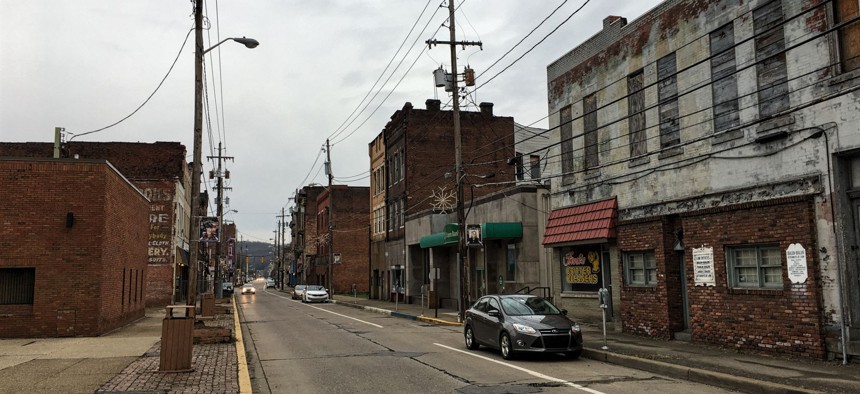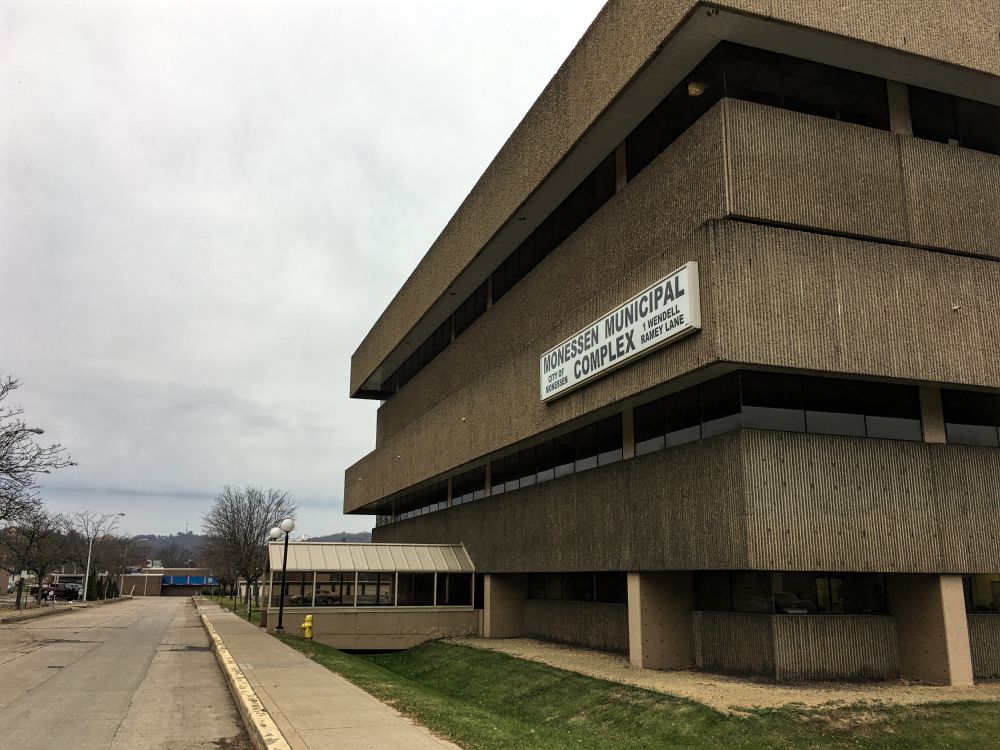Mayor of Former Steel Mill Town Hopes Federal Aid Will Flow Under Trump

Donner Avenue in Monessen, Pennsylvania Bill Lucia / RouteFifty.com

Connecting state and local government leaders
“If there’s ever an opportunity, it’s now,” says Mayor Lou Mavrakis of Monessen, Pennsylvania.
Editor’s Note: This is the first installment in an ongoing series of articles examining economic development challenges in cities and localities.
MONESSEN, Pa. — With Donald Trump elected president and Republicans in control of Congress, the outspoken Democratic mayor of this one-time steelmaking hub south of Pittsburgh sees a chance to secure federal funds to help clean up decaying buildings in the city.
Mayor Lou Mavrakis wrote several letters to the White House this year making a case that Monessen was in bad financial and economic shape and needed help. But the mayor says he never received a response from President Obama or his staff.
“Never heard one word,” Mavrakis, who is in his late 70s, told Route Fifty in a recent interview. Earlier in his career, Mavrakis worked in a local steel mill and was later an international representative for the United Steelworkers union.
Resorting to another approach to draw attention to his town’s plight, the mayor over the summer contacted Trump’s campaign.
The president-elect in late June gave an economic policy speech in Monessen, during which he blasted U.S. trade policies and promised to boost industrial segments of the nation’s economy that have seen declines, such as mining and steelmaking.
Monessen is located about 30 miles south of Pittsburgh along a bend in the Monongahela River.
The steel industry once provided thousands of jobs here. But Wheeling-Pittsburgh Steel Corp. shut down the furnaces at its mill on the riverfront about three decades ago. Page Steel and Wire Co., which supplied wire and cable for California’s Golden Gate Bridge, is also gone.
An ArcelorMittal plant that produces coke—a product made from coal that is used for steelmaking—is in operation. It employs around 180 workers. Piles of coal are heaped on the grounds of the facility and its smokestacks rise above downtown Monessen.
The city has about 7,500 residents and has long been considered a Democratic stronghold.
Hillary Clinton carried the municipality in this year’s presidential election with 55 percent of the vote, according to results from Westmoreland County. Roughly 42 percent of the city’s 3,381 voters backed Trump. In contrast, Mitt Romney, the Republican up against President Obama in 2012, captured just 33 percent of the vote.
“Clinton took them for granted,” Mavrakis said of local voters, as he discussed the November election at his office in the Monessen municipal complex building last week.
Trump edged out Clinton in Pennsylvania by about 49,500 votes of the roughly 6 million cast.

‘Now or Never’
Since the election, Mavrakis said he’d spoken with U.S. Rep. Bill Shuster, a Republican who represents Pennsylvania’s 9th congressional district, which includes Monessen. Shuster’s great-grandfather served as the city’s burgess—a position akin to mayor—in the early 1900s.
“He said we have a Republican Congress and Trump is aware of the Rust Belt problems that we have and he was here,” Mavrakis recalled of his conversation with Shuster. As for getting money to help clean up blight, he added, the congressman said: “it’s either now or never.”
Shuster’s office last week confirmed that he had met recently with Mavrakis.
The congressman expressed support for city efforts “on the local, state, and federal level regarding blight removal,” his communications director, Casey Contres, said in an email Friday. “Funding for issues like this typically come more from the state and local level,” he added. “But he’s offered any assistance he can give to finding and securing any available funding or grants.”

How much money is Mavrakis looking for?
“Really I need 10,” he said, meaning $10 million. “But a minimum of five.”
He thinks the federal government should offer this sort of assistance to 10 or 20 communities like Monessen—places that were hit hard by the collapse of steel and other heavy industries.
“Give them the money, let them see what they can do,” he said.
Pointing to large sums the U.S. has funneled toward initiatives in foreign countries, Mavrakis says the funding he’s asking for amounts to “chump change” and “goddamned petty cash.”
The mayor wants the money to pay for demolishing dozens of vacant and abandoned buildings in the city. Getting rid of the structures, he believes, will give Monessen a shot at attracting new businesses. One possibility he mentioned was clothing manufacturers.
What does the city have to offer? The prospect of free or inexpensive land for development, he said, and there’s easy access to the river, railroad tracks and Interstate 70.
‘It Inches Its Way Up’
As he stood downtown near the intersection of Donner Avenue and Fifth Street, gesturing toward a vacant three-story, brick structure that hulked over the corner, Mavrakis growled: “Look at that building.”

In some windows the glass was gone. Others were covered by plywood. A ragged pigeon, the feathers missing from one side of its neck, flapped into view at one point behind a pane of glass on the ground floor. Up the block was another abandoned building. Pushing open the front door revealed a bathtub in the entranceway, debris strewn on the floor and graffiti on the walls.
Buildings like these are not unusual in Monessen. Mavrakis estimates there are about 30 such structures in downtown, along with about 400 blighted houses. He pointed out a bowl of cat food on the porch of one dilapidated house. “People put out cats to keep away the rats,” he said.

Parts of the city, however, especially those that are further from downtown, are untouched by this deterioration. Along streets like Grand Boulevard and State Road, tidy suburban homes, with driveways and manicured lawns can be found.

But referring to the blight in and around the city’s core, Mavrakis warned: “What you have down there, it inches its way up.”
Where Could the Cash Come From?
How the money the mayor is looking for might flow to Monessen is unclear.
After Mavrakis wrote to the White House, he said the U.S. Department of Agriculture reached out to discuss the possibility of a loan to help the city pay for sewer upgrades that Mavrakis estimates to be in the ballpark of $40 million to $50 million.
But the mayor said the city can’t afford to take on any more debt.
Monessen received about $300,000 of federal Community Development Block Grant funding each year between 2011 and 2015, according to figures provided by Pennsylvania’s Department of Community and Economic Development. Mavrakis said some of this money has gone to tear down vacant houses, but that it cannot be used for demolishing buildings downtown.
The Department of Community and Economic Development offers access to a variety of programs small cities could use to combat blight, but none that are designed specifically for that purpose, a department spokesman said in an email. He added that without knowing details about a local government it wasn’t possible to say precisely what support might be available.
Thomas Williams, Pennsylvania state director for U.S. Department of Agriculture Rural Development, said vacant building demolition is an eligible way to spend some of the agency’s grants and loans, but it would need to be part of a broader project that meets certain criteria.
For instance, a locality could use USDA rural development dollars to raze buildings if they’re removed to construct a facility such as a library, or a hospital, or water or wastewater infrastructure. But the money cannot go to standalone blight remediation projects.

Tight Local Finances
Asked why the city doesn’t come up with the money on its own, Mavrakis said that the local budget is stretched to the limit. And, he said, it’s not a realistic option to raise taxes when many city residents are elderly and just scraping by financially.
“You can’t raise anything on these people,” he said, “they’re strapped.”
The median household income between 2010 and 2014 was $32,970 in Monessen, compared to $53,115 for all of Pennsylvania, according to the most recent U.S. Census Bureau estimates.
The $5 million the mayor wants is on par with the $4.5 million in total appropriations outlined in the city’s 2016 budget. Monessen had about $7.3 million in long-term debt as of Dec. 31, 2015. Moody’s Investors Service in May downgraded the city's general obligation credit further into junk territory, to a Ba3 rating.
Mavrakis has emphasized that Monessen’s outstanding debt was already issued by the time he took office in 2014 and argues that the city has been working to cut costs.
The city is moving forward with a plan to sell the municipal complex building where its offices are housed, for a price of about $425,000. A medical equipment and supply company appeared to be the top bidder, the mayor said late last week.
Asked about the grant and loan programs that are typically options for cities of Monessen’s size, Mavrakis scoffed. “What good is $50,000?” he said. “I need millions.”

During a less unusual chapter in U.S. politics, the likelihood Monessen would net $5 million from the federal government, simply because the mayor agitated for the money, would seem far-fetched.
But as the Trump era begins, it's less clear whether Mavrakis’ quest has any chance of success.
“If there’s ever an opportunity,” he said, “it’s now.”
PREVIOUSLY on Route Fifty:
Bill Lucia is a Reporter for Government Executive’s Route Fifty and is based in Washington, D.C.

NEXT STORY: How a Simple Sticker Can Nudge Residents Into Compliance





